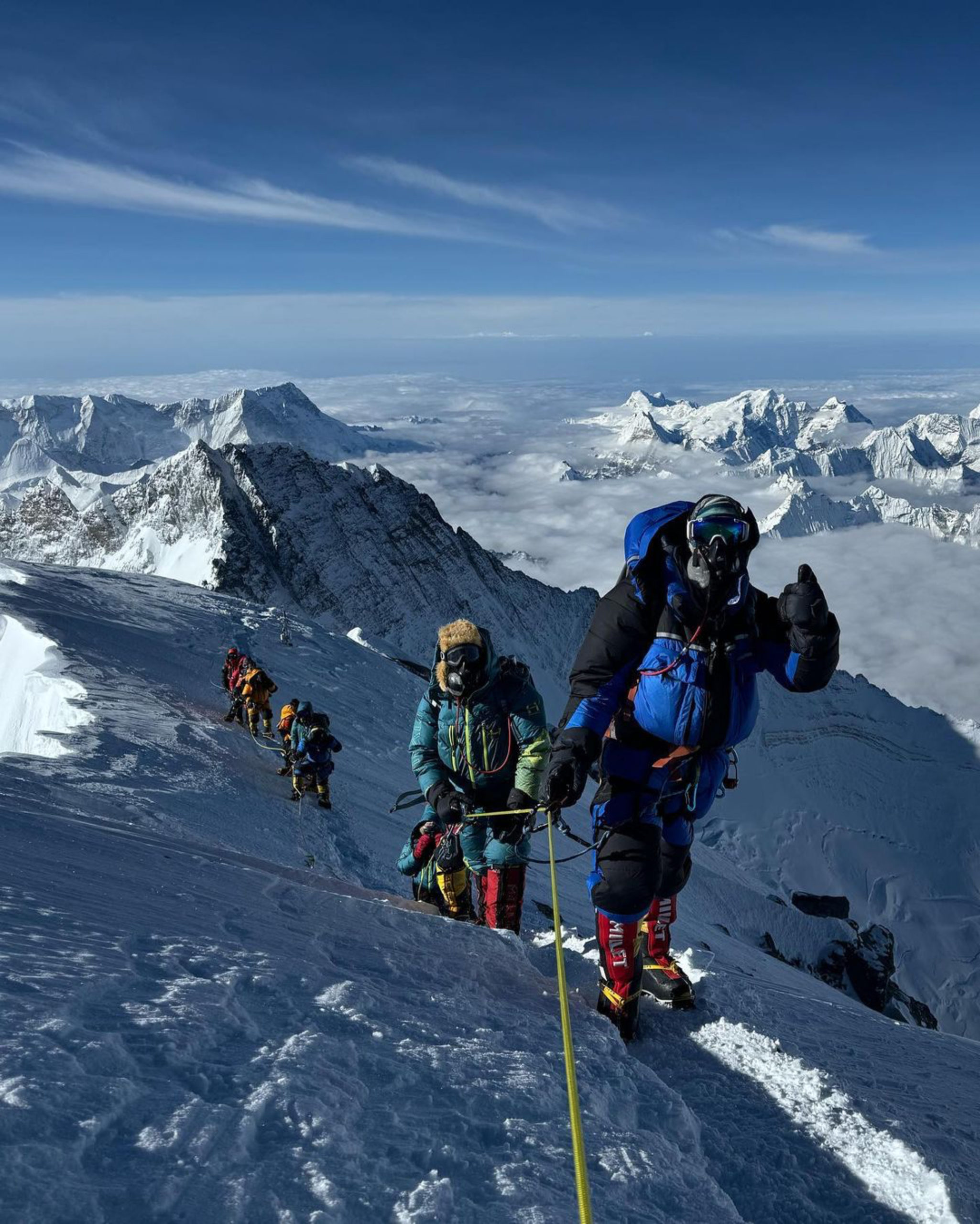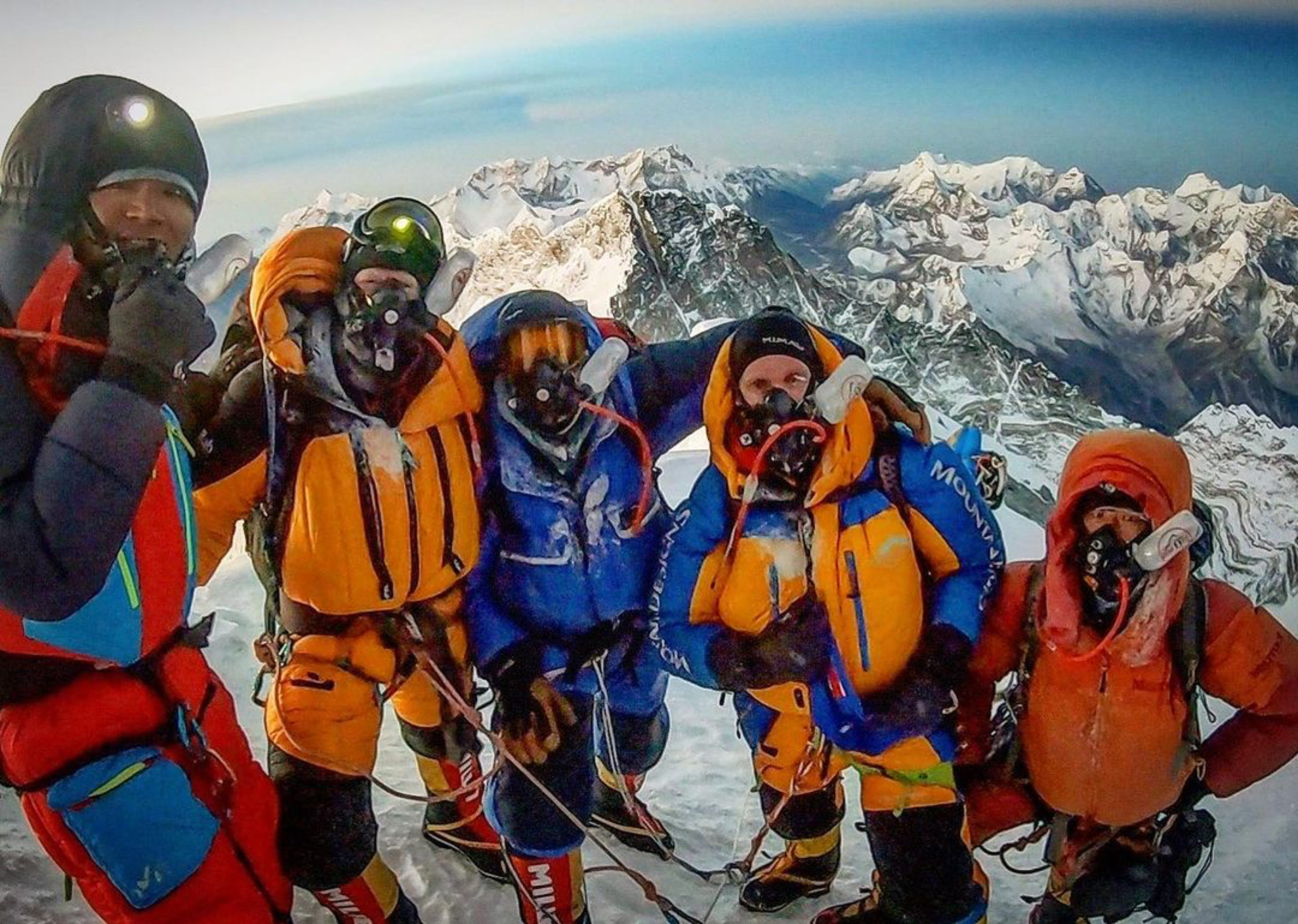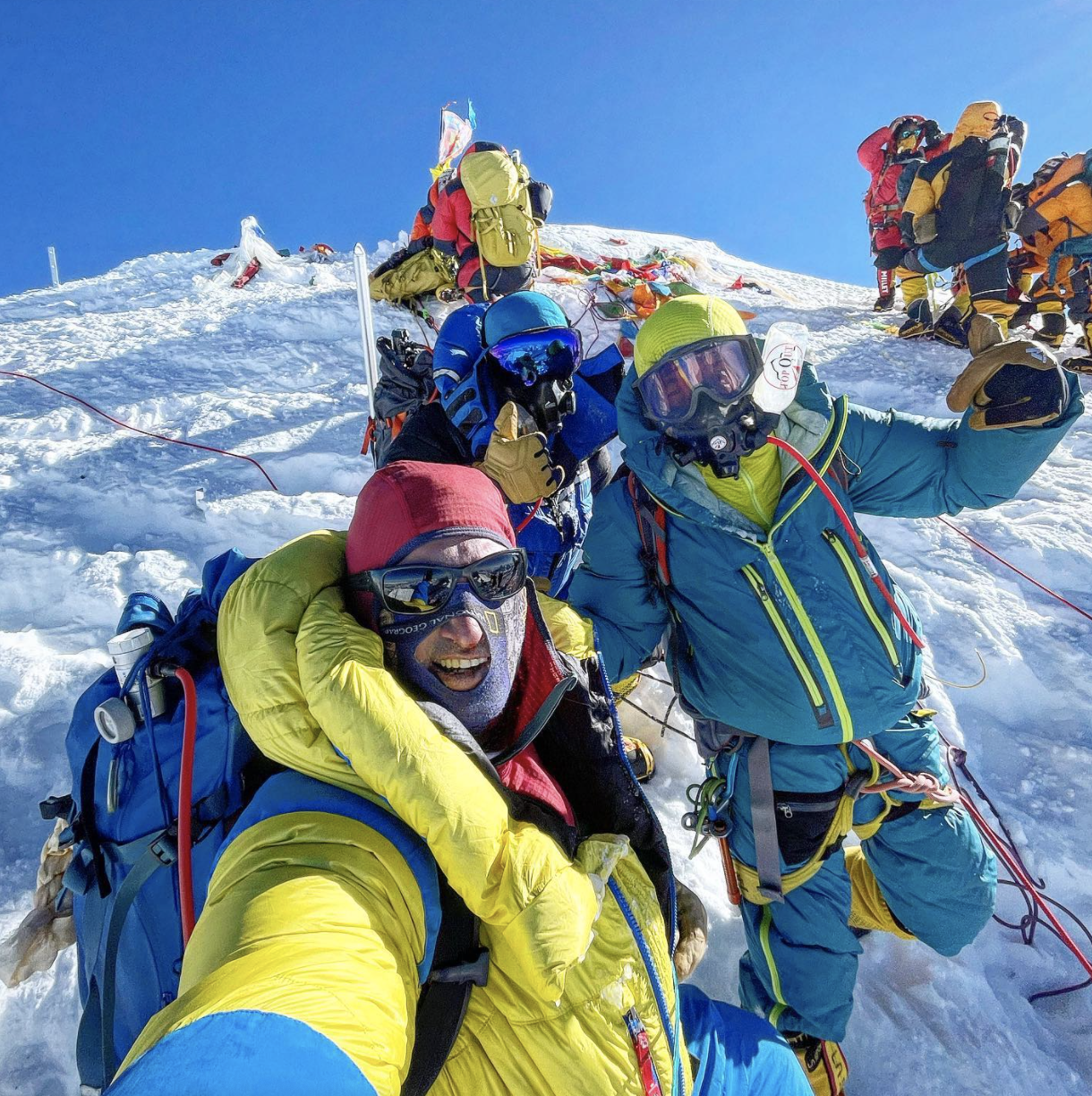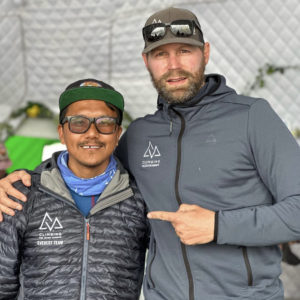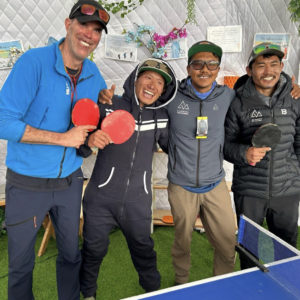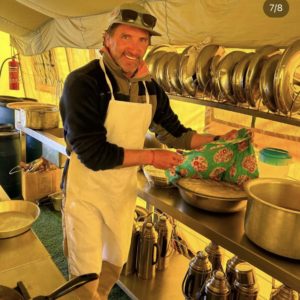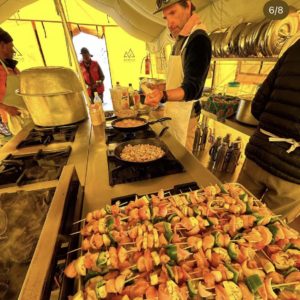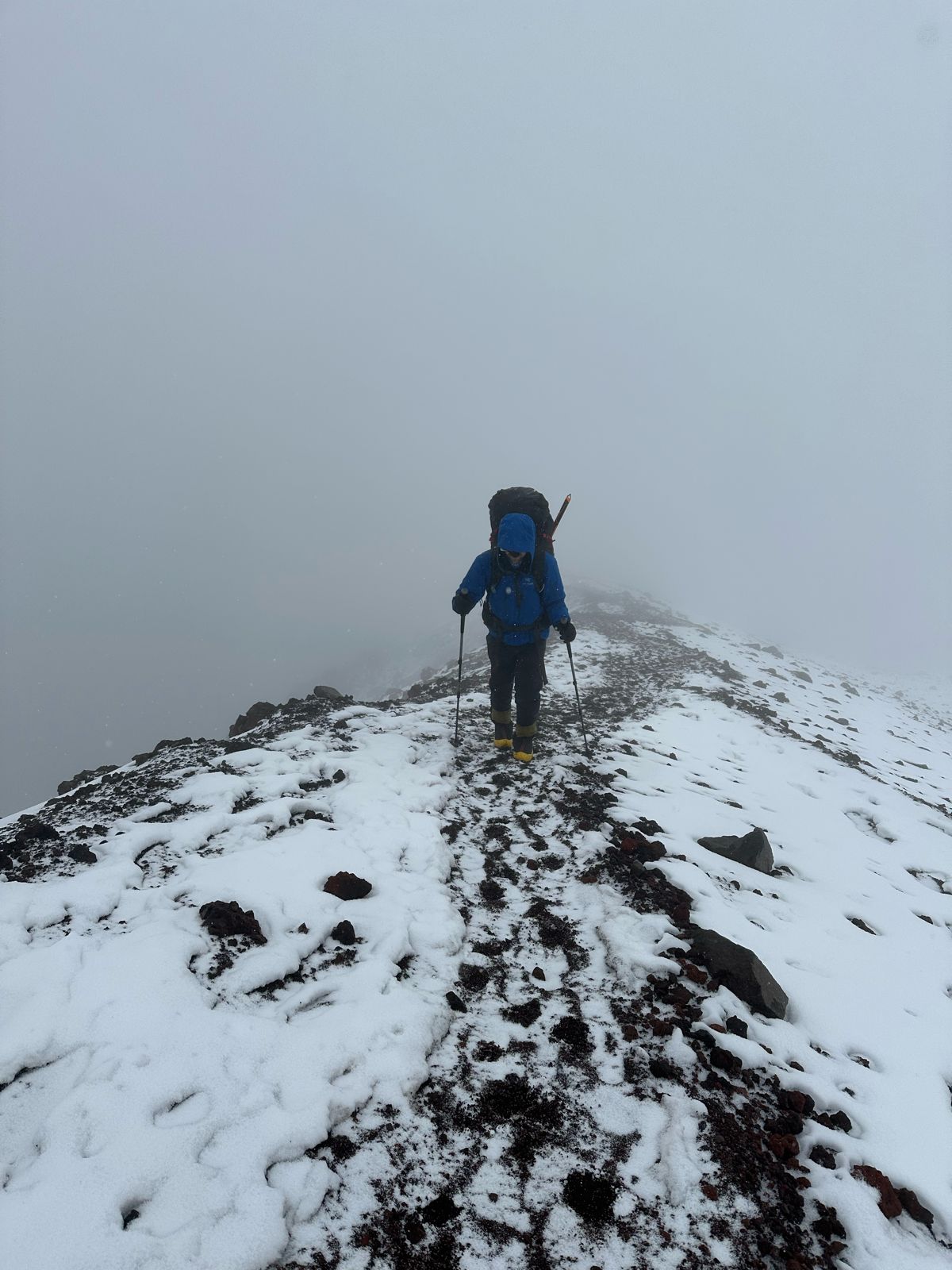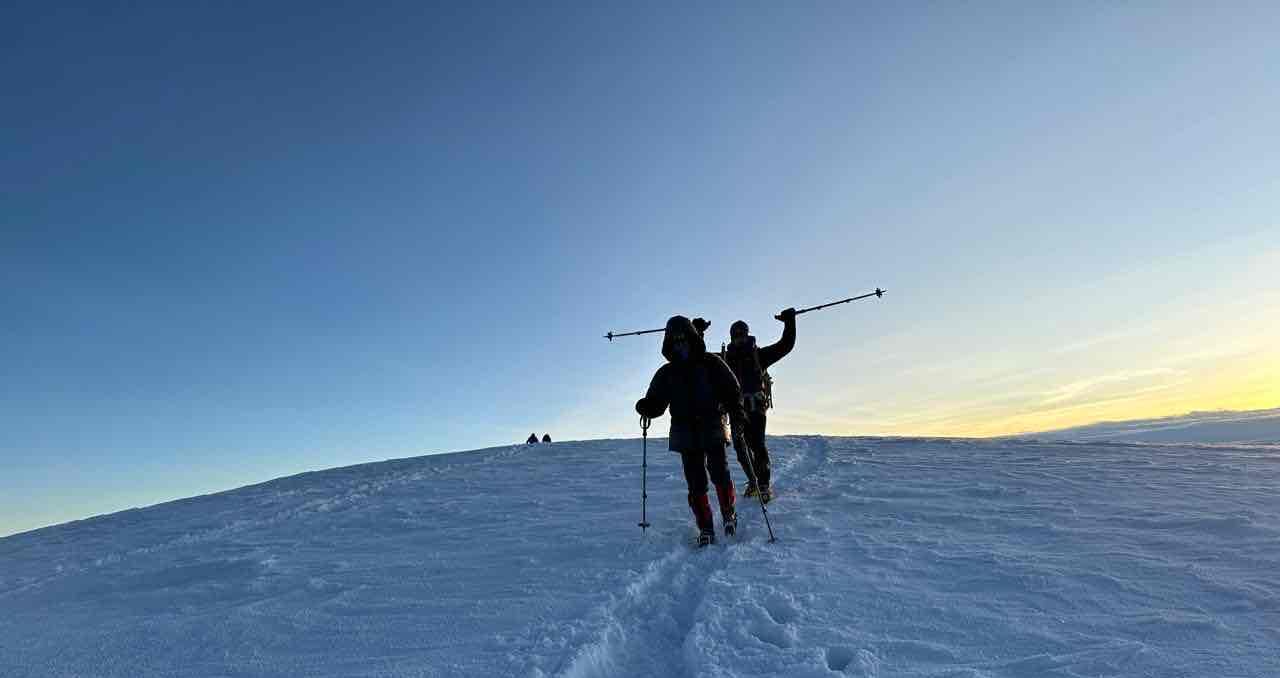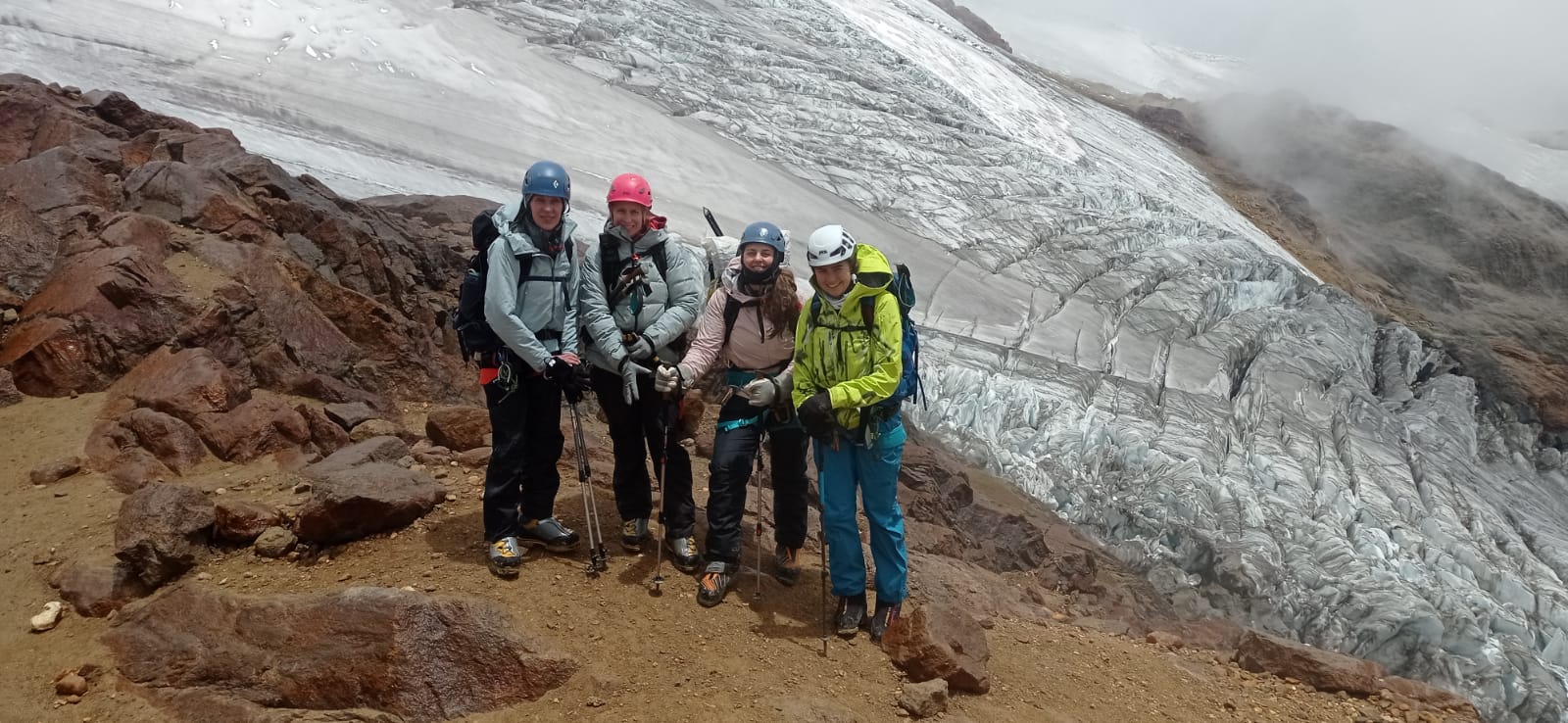Everest Base Camp Celebrations
What an incredible last few days for our first summit team.
Summiting in great weather, watching the sunrise from the top of the world, creating friendships that will last a lifetime, experiencing the power and beauty of the world's tallest peak, and most importantly, feeling what it's like to walk safely back into Everest Base Camp after a successful climb.
Once again, huge congrats to the climbers. To the climbers and their families and friends - thank you for trusting CTSS to support you in this massive goal.
The team is all back at Everest Base Camp, celebrating their achievements, including Tendi Sherpa, below, who just completed his 16th summit on Mount Everest.
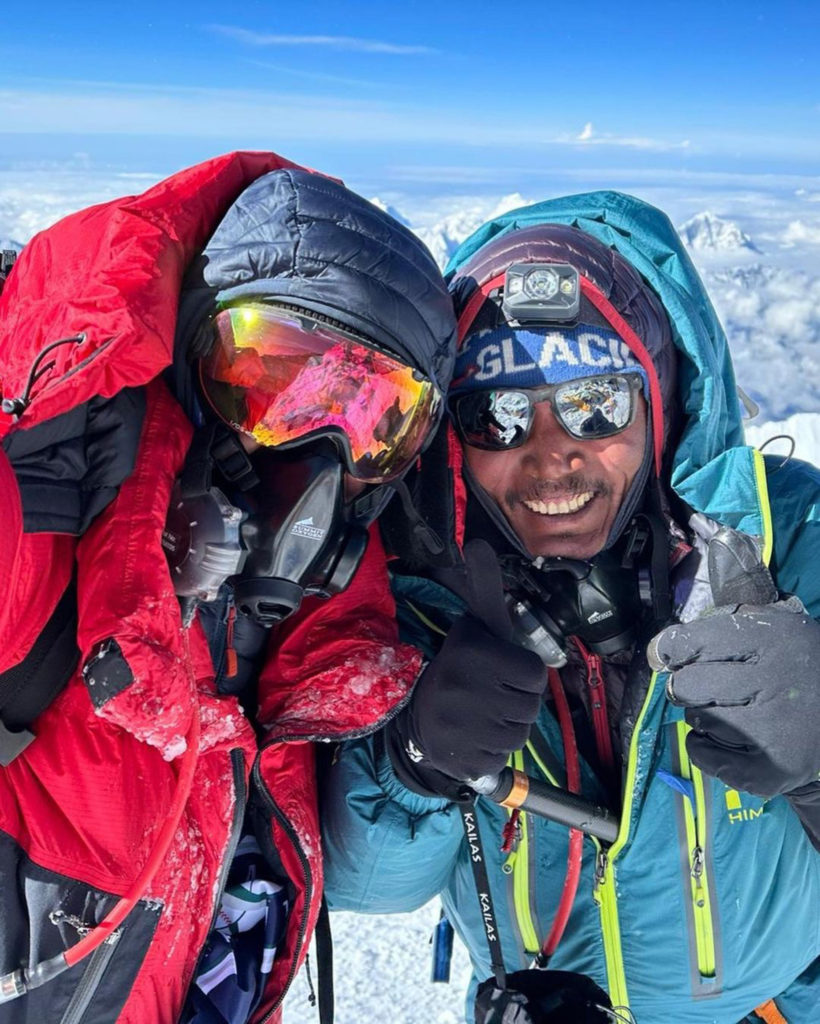
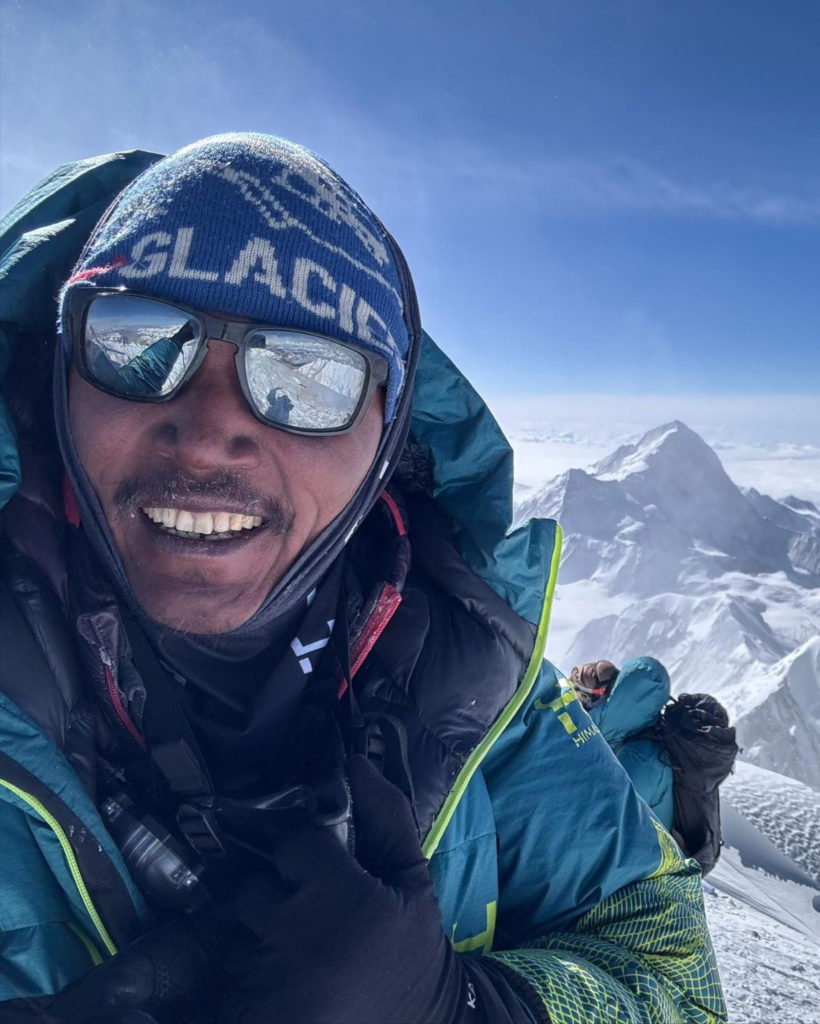 Tendi Sherpa (in blue) on the summit of Mount Everest, marking his 16th summit on the world's tallest peak.
Tendi Sherpa (in blue) on the summit of Mount Everest, marking his 16th summit on the world's tallest peak.
Some climbers will helicopter out to get back to friends and family (and newfound fame), while others will relish walking back down the Khumbu Balley slowly with their teammates. Either way, they will have memories that will last a lifetime.
Below are a few of the incredible images for their summit. Photo credit to Nanika Stahringer, Tendi Sherpa, Josh McDowell, and Ashish Gurung.


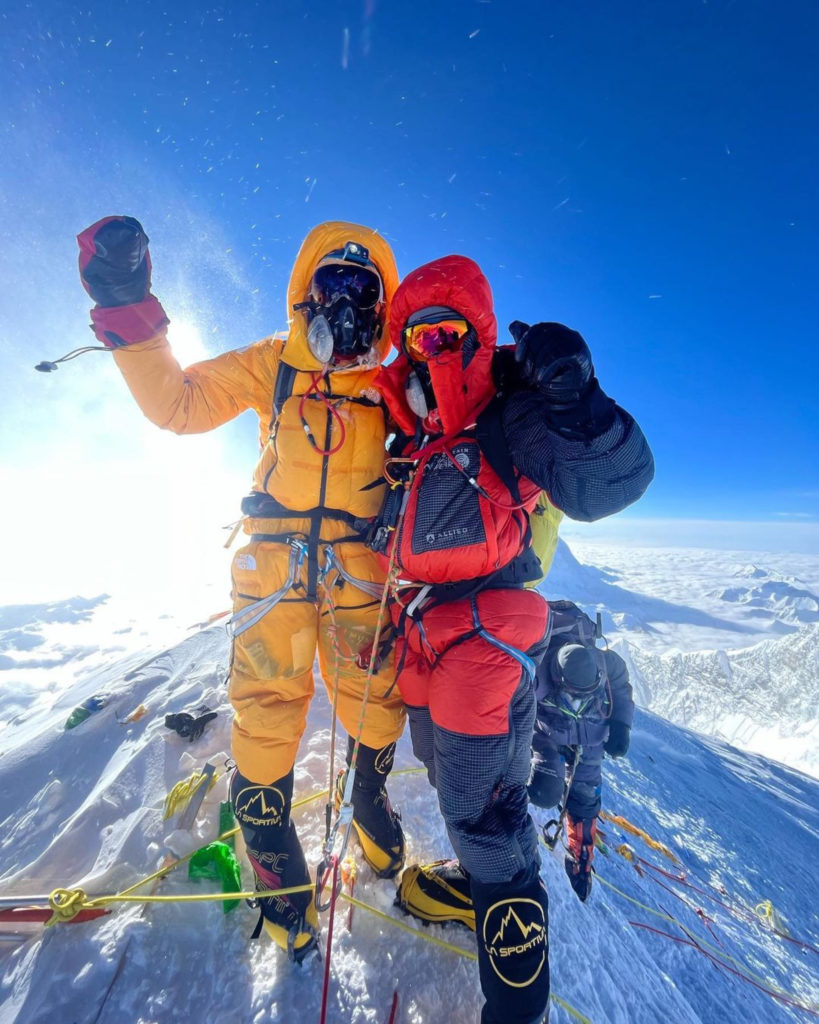

And, of course, a welcome celebration at Everest Base Camp. Photo credit to Nanika Stahringer, Tendi Sherpa, Josh McDowell, and Ashish Gurung.



Summit Teams Return to Camp 2
The entire summit team is now safely back to Camp 2. It was a huge day, nearly 24 hours on the move, but they elected to drop down to move off the windy South Col and sleep better. They will likely be back in Everest Base Camp tomorrow to celebrate and rest.
The second half of our team is patient and strategic, looking for the best summit window for their bids.
Once again, congratulations to all 26 climbers who stood on top yesterday on a great summit day with no crowds.
Here's a look at what the summit bid is like for our Everest climbers:
26 Everest Summits on May 13, 2024
Morning of 13th May (Local Nepal time)
A huge congratulations to our climbers, guides & Sherpas.
We are so proud to announce that all 26 climbers who left on their summit bid today have successfully stood on top of Mount Everest.
Including:
- Ms Lee Donald
- Mr Bert Snarr
- Mr Thomas Smith
- Mr Michael Fortune
- Mr David Keating
- Mr Terry Ledgard
- Mr Jared Harris
- Mr Patrick Monday
- Mr Josh McDowell (Guide)
- Mr Manuel Stahringer (Guide)
- Dawa Furten Bhote
- Pasang Bhote
- Dawa Jyabu Bhote
- Nuru Sherpa (Papchhe)
- Pasang Rinji Sherpa
- Dawa Sherpa (Ramete)
- Dorjee Sherpa
- Milan Tamang
- Jangbu Sherpa
- Thunang Lhomi
- Sujan Gurung
- Gyalbu Tamang
- Pasang Tendi Sherpa
- Sona Sherpa
- Ang Tshering Sherpa
- Ashis Gurung
The team are now making their way back down to the South Col. Please know that no news is good news. The winds are forecast to pick up a little, so the team is moving efficiently and not stopping to pull out radios unless absolutely necessary.
What a way to celebrate Mothers' Day! Congratulations to all.
Photos CTSS Archives

First Everest Summit Bids Underway
Evening Sunday 12th May
Summit bids are underway, with the traditional Western Guided Team climbers heading out of the South Col at approximately 8:30 pm Guided by Josh McDowell and Nani Strahringer.
We are looking at no crowds and clear skies as they climb throughout the night and into the morning. We expect summits early on the 13th around or just after sunrise. Please remember that no news is good news. It is a long summit day, and it is not unusual not to hear much as Guides conserve radio batteries. It's a case of heads down, keep moving. We will announce successful summiteers when they are back at the South Col.
If you want to see the route and what your climber is currently experiencing, take a quick look at: https://youtu.be/jsHzfy8yO6E?si=zN96aQ-FsThm7AKU
The remainder of the team is at Everest Base Camp preparing for their summit bids.
We are excited to keep you updated.

Summit Team Staged at Camp 3
Evening of Saturday 11th May
Hello from the Himalayas! We hope you are all rolling into a fabulous Mother's Day weekend and spoiling those moms/mums of yours! Apologies to the mums of our Western Guided Team who are above Base Camp right now, as they won't be able to send a message to you all, thanking you for all your support and love and for helping them get here and live out their dreams. We honor you.
At Camp 3 we have:
- Bert Snarr
- Tom Smith
- Adam Kennedy
- Michael Fortune
- David Keating
- Terry Ledgards
- Jared Harris
- Pat Monday
- Lee Donald & Personal Sherpa Thunang Bhote
- Guide Josh McDowell & Guide Nani Strahringer.
They climbed the Lhotse Face strongly today - leaving early, at about 5 am, when the face was cold to minimize rockfall, and pulled into Camp 3 in good style and good time. They are sleeping on oxygen now and will remain on oxygen throughout their summit bids.
In the morning, they will keep heading up the Lhotse Face, through the Yellow Band, up to the South Col (Camp 4) at 8000m, where they will rest and get some sleep before they begin their summit attempts! We have winds in range throughout the night of the 12th and morning of the 13th, forecast to pick up more later in the afternoon of the 13th. There are no crowds which means they will be able to move smoothly and efficiently. We are so excited for them and wishing them the best of luck.
Check out their route below:
Back at Everest Base Camp, readying for their window are:
- Ruben S
- Marc B
- Randall E
- Chen (Blake) Li
- Yinghong H
- Riki J
- Pascale S
- Aga O
- Darragh O
Everything is smooth, let's head to the summit!
Photos from the CTSS Archive
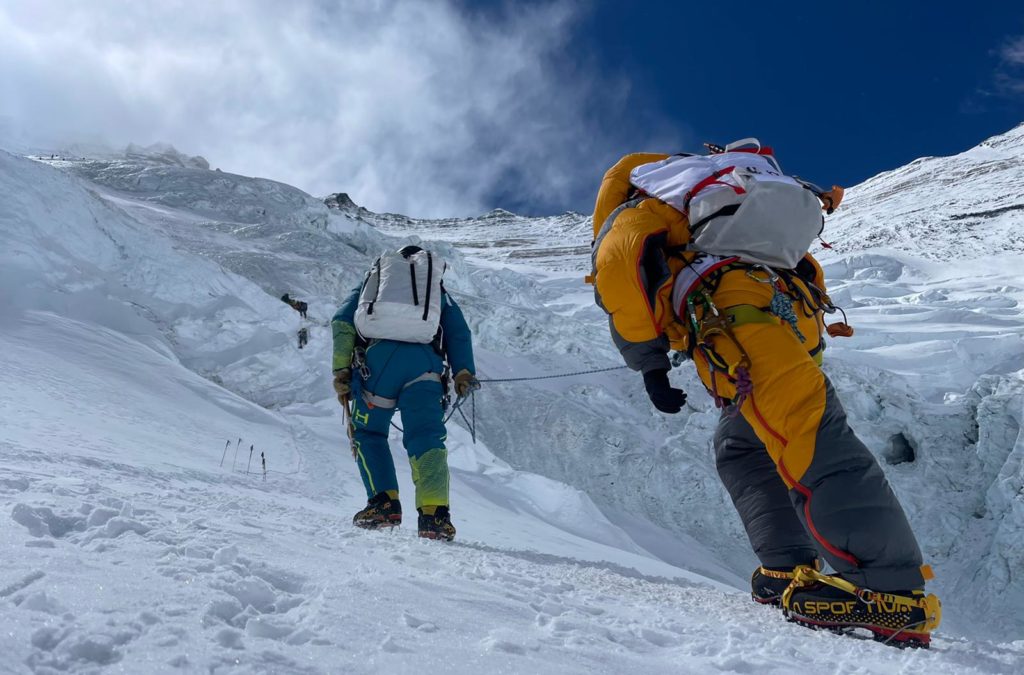
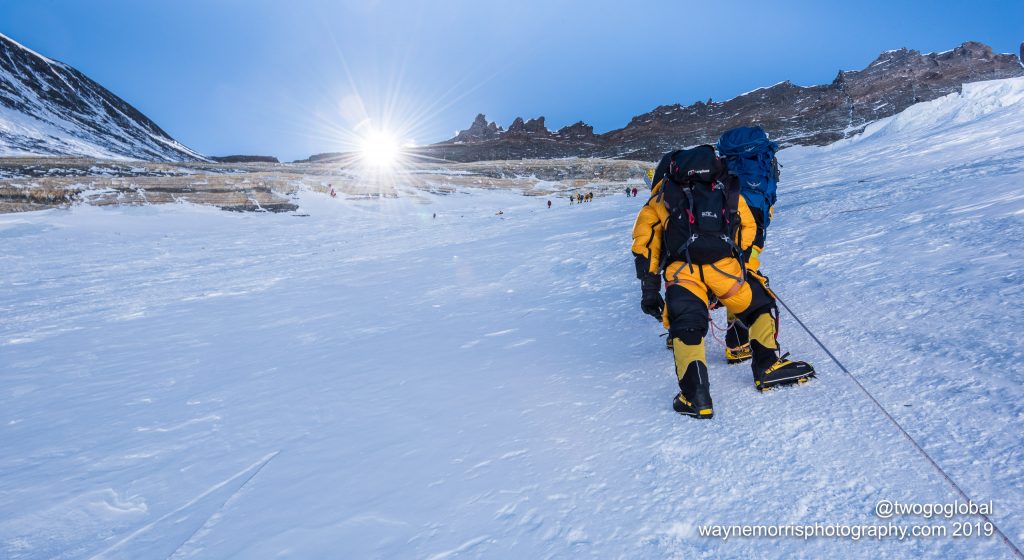
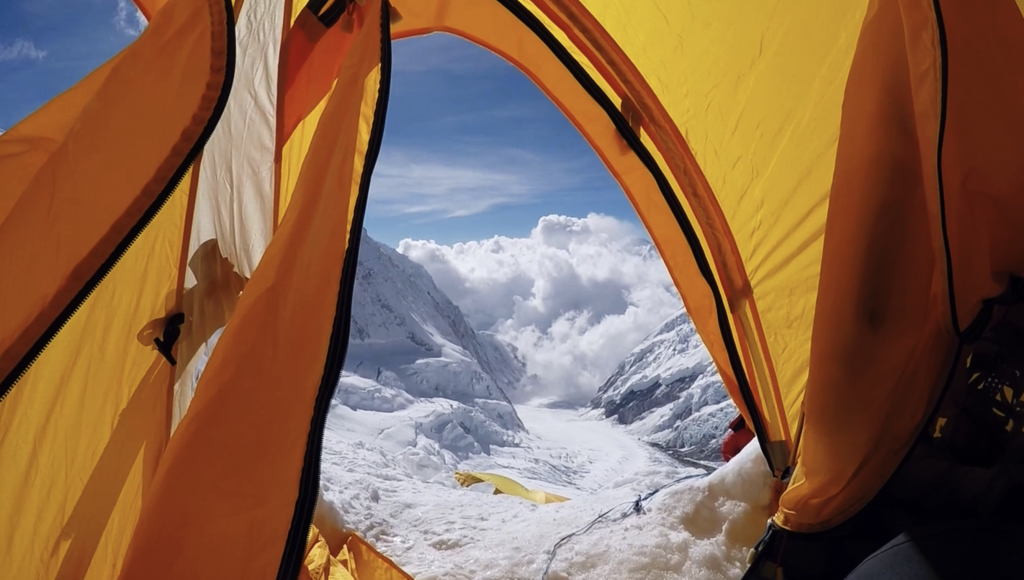
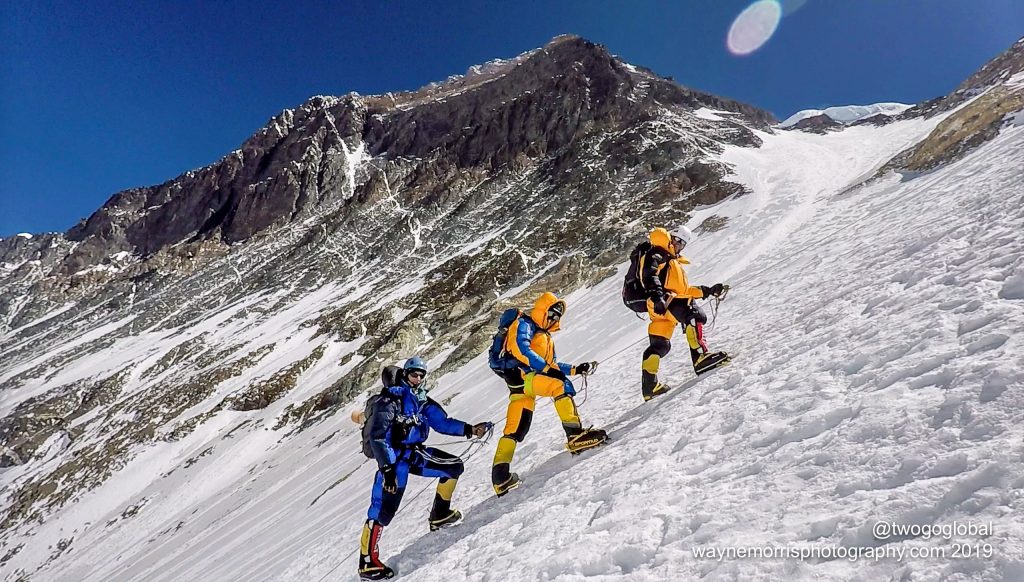
The Start of Summit Bids on Everest
Evening of May 10th
The forecast is favorable.
The winds are within range.
The route is ready, thanks to the summit rope fixing team.
Our team is feeling strong and eager.
It’s go time!
Our Western Guided team is tucked in at Camp 2. They plan to start climbing at 5am local time up to Camp 3, where they will spend tomorrow night, before continuing toward the summit.
The 1:1 Private Guided and Personal Sherpa climbers are at Everest Base Camp, recovering and resting from their last rotation. They are all excited as they begin to prepare and strategize for their summit bid.
Exciting times in Nepal!
 Summit bids are starting! Here's to continue good weather and strong energy.
Summit bids are starting! Here's to continue good weather and strong energy.
The World's Highest Ping Pong Tournament
We are getting excited as we move closer and closer to summit bids. With the team fully acclimatized, all eyes are on the forecast, specifically the winds. We are looking for an opportune moment. The team is eager, the logistics are in place, and we are excited to get things underway.
While we wait, we knew it was the perfect time to host the World's Highest Ping Pong Tournament. The results are in, and guide Pega narrowly edged out Dawa Yolmo in the finals to successfully defended his 2023 title. Congrats to all the ping-pong players!
If you're climbing with us in 2025, this is your sign to start brushing up on your ping-pong skills as part of your training regime. For real. The Sherpas are hard to beat.
Meanwhile, guide Tomi has taken over the kitchen and is whipping up some incredible Argentinian fare as well as pizza and chicken brochette skewers.
Ecuador Volcanoes Advice from Mike Hamill
Ecuador Volcanoes Advice from Mike Hamill
Share Expedition
Personal advice on climbing in Ecuador from Mike Hamill
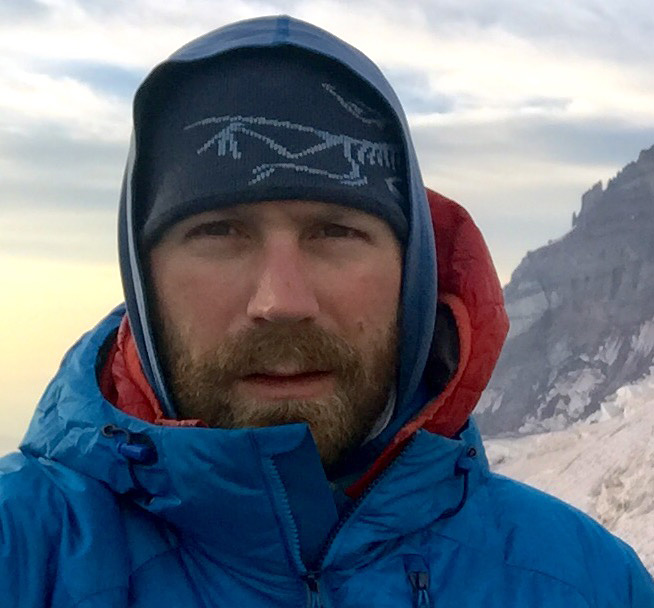
If you’re looking for the best bang for your buck in mountaineering, Ecuador delivers. You get multiple high-altitude summits, glaciated terrain, technical variety, and cultural richness, all packed into a tight timeframe. It’s one of the most efficient and rewarding expeditions on the CTSS calendar. For anyone training for bigger objectives like Aconcagua, Denali, or Everest, this trip gives you serious mountain mileage at a fraction of the cost. But it’s not just a tune-up or a progression; it stands on its own as an unforgettable adventure.
One thing I always remind climbers: Ecuador kicks off fast. Within a couple of days of arriving, we’re climbing above 16,000ft. That means your body needs to adapt quickly. I recommend speaking with your doctor ahead of time about starting altitude medication before you go above 10,000 feet. It can give you a significant edge and help you feel stronger earlier in the trip.
The weather in Ecuador can be unpredictable. You might start a climb under sunny skies and finish it in a whiteout. I always wear and pack a complete layering system in my pack: a base layer, a fleece or mid-layer, a shell, and an insulating puffy jacket because conditions can change quickly, and you want to be prepared. One piece of gear I constantly see people underestimate is eye protection. Even on cloudy days, snow blindness is a real threat. Bring a solid pair of glacier glasses (and a backup), and I also recommend something like a face glove. It’s a cost-effective and lightweight way to protect your nose and cheeks from the sun while also reducing fog on your lenses.
And finally, one of my favorite parts of this trip is the cultural immersion. Between climbs, there’s unavoidable drive time, but I see that as a chance, not a chore. I always bring a book on Ecuador’s history or download a couple of podcasts. Learning about the country while physically moving through it adds so much to the experience. The haciendas we stay in are steeped in history, and the local teams we work with have great pride in their heritage. The more you engage with the people and places, the more connected you’ll feel to the mountains you’re climbing. For me, that’s what elevates this expedition beyond just the summits; it becomes a full-circle, enriching journey.
Ecuador Volcanoes Training & Prerequisites
Ecuador Volcanoes Training & Prerequisites
Share Expedition
Experience Level
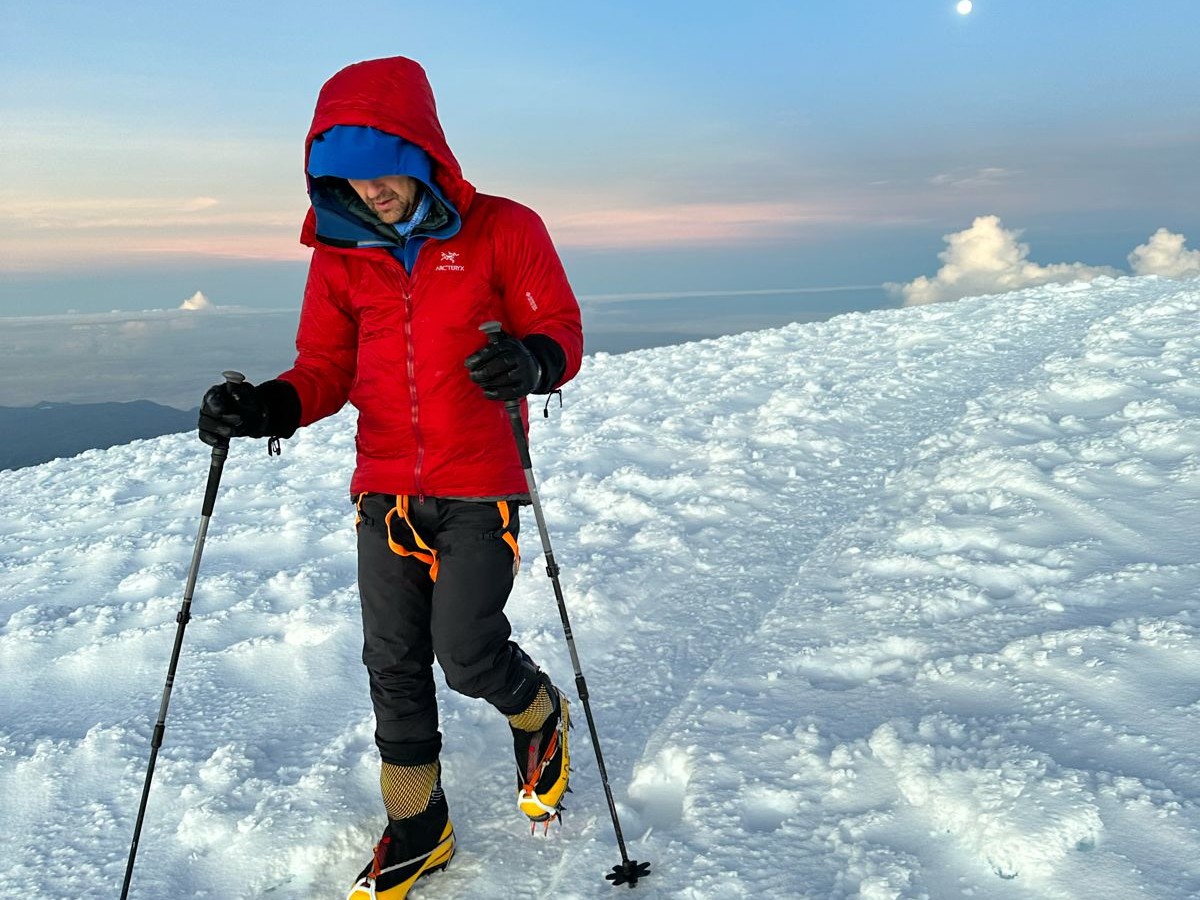
This program is of moderate difficulty and is great for those with previous experience with crampons, ice axes, and rope travel on peaks such as Mount Baker and Mont Blanc. It requires solid fitness and an ability to perform well at altitude, but it is not beyond the abilities of who are willing to train diligently for the climb for 4-6 months ahead of time and work hard on the trip.
If you are an advanced beginner, meaning you have previous hiking and trekking experience, you are welcome to join us on this expedition but please note that this climb will be challenging and test your limits. We will do a brief snow school during the team climb and we also offer a Pre-Expedition Acclimatization & Skills Training Add-On which can help refresh or extend your knowledge prior to the expedition. If you want to join this climb but feel unsure of your ability, chat with us and we can work with you to get you up to speed prior to the climb, as we take immense pride in helping people achieve their goals.
Physical Training
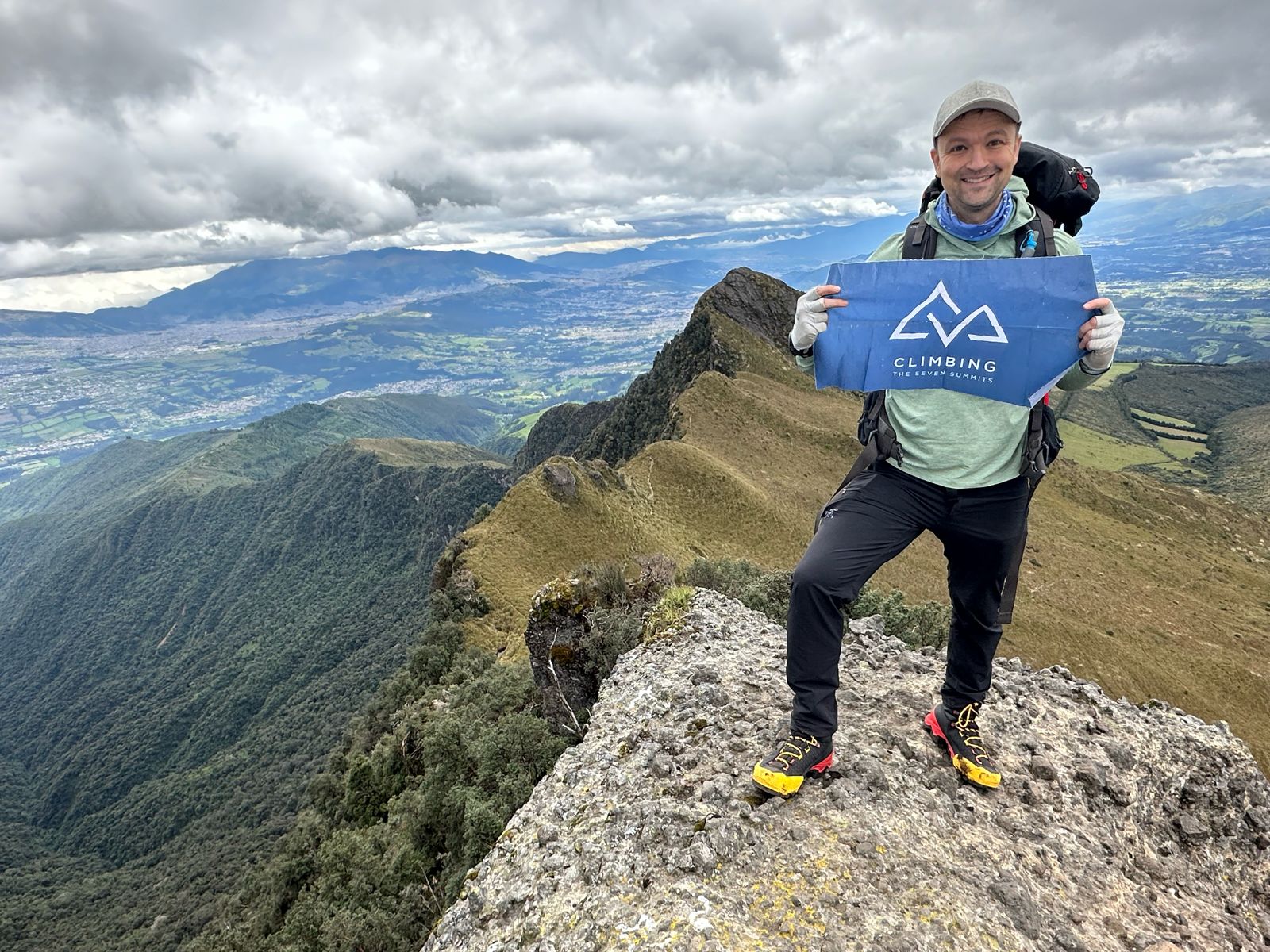
Your climb begins long before you reach Ecuador. We encourage you to incorporate training into your daily routine at least six months before the departure date. As your climb rolls around, you want to be in top physical and mental condition. Being fit at home is different from being strong at high altitudes and in extreme conditions.
By the time you depart, you should be comfortably able to do multi-day hikes with strong elevation gain carrying a 40-lb pack. While you won’t necessarily always have a pack that heavy in Ecuador (you will be carrying all of your gear to the Cayambe and Cotopaxi huts and, if you do the Chimborazo add-on, to high camp), it is a great way to build your power and strength in the areas you will need it. The average pack weight in Ecuador is 20 lbs (10kg) on a hiking/climbing day and 30 lbs (15 kg) on a day we are carrying to/from a hut or high camp.
We advise a training plan that includes the following:
- Hiking uphill along outdoor trails with a heavy pack for an hour or more at least 3x per week, aiming for 1,500 vertical feet per hour.
- Longer weekend back-to-back hiking days or climbing expeditions
- Cross-training sessions, such as stair training, running, cycling, swimming, etc.
- Strength-specific training that focuses on the lower body and core.
- Interval training that boosts cardiovascular fitness and conditions your body to anaerobic conditions. Slowly increase your training (time, distance, elevation gain, etc.) each week.
Training should be done gradually to reduce the risk of injury and build yourself up over time. Please be aware that bodybuilding workouts are not as effective as endurance and climbing conditioning training. Yes, you need to be strong and put weight on before your climb, as you will inevitably lose body fat and muscle, but merely bulking in the gym shouldn’t be a substitute for climb-specific cardiovascular training and strength.
Knees are often flagged as a concern. If you need to strengthen your knees, consider hiking with water weight in your pack, empty the water for your descents, and slowly build your knee strength. Soon you will be able to descend with the same amount of weight as you climb up with as your knees strengthen.
Whatever training you choose, you need to be working out five days per week for 45 minutes or more. This is really the bare minimum. Most climbers do cardio fitness nearly every day that is fairly specific to hiking uphill and works similar muscles on the descent without the impact. Aim for 3,000 to 5,000 vertical feet per day at least once a week and twice a week in the few months leading up to the climb.
Again, it is important to put time in before the trip in order to make the climb easier and more enjoyable. You don’t want to merely struggle to the top; instead, enjoy the experience by being in good enough shape to summit comfortably. Try to increase your workout intensity and duration gradually so you peak about a week before the start of your climb.
There is no substitute for hiking with a pack, as that is the basis for any high-altitude climb. There is no better excuse to get in shape than training for a goal such as these climbs!
Mindset
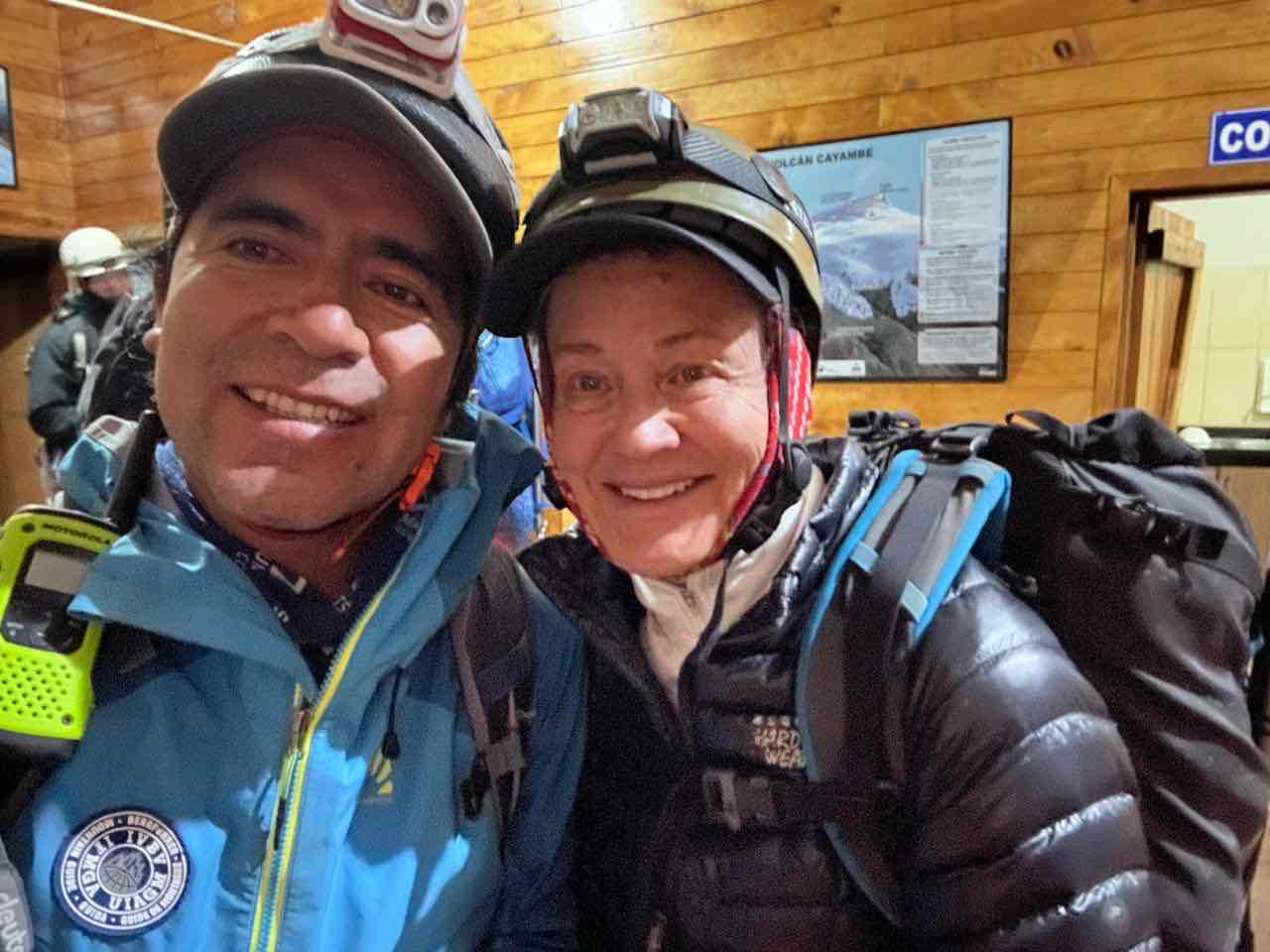
Mindset and mental preparation are integral to your success on any peak.
You should be prepared to:
- Be away from home/work for the duration of your climb
- Have a desire for rugged adventure travel
- Be open to receiving and deferring to guidance, support, and advice from your guides/expedition leaders, even if you are an experienced mountaineer
- Be comfortable having open conversations with your guides
- Be able to work well in a team environment by being supportive and respectful of fellow teammates
- Be humble, respectful, and considerate even under pressure
Ecuador Volcanoes Expedition Beta & Route
Ecuador Volcanoes Expedition Beta & Route
Share Expedition
Elevation: 18,996 – 20,548 feet
Duration: 11 – 14 days
Difficulty: Advanced Beginner to Intermediate
Route: Standard Route
Continent: South America
Climbing Cotopaxi
On Cotopaxi (19,347 feet), we will be based out of Tambopaxi Lodge, just below the peak. We will do our acclimatization hikes and a day of training to refresh our skills, and then it’s time for the real climbing to begin! Our team will drive to the mountain and hike for about an hour to arrive at Refugio José Rivas, a dormitory-style mountain hut, where we will settle in, have our pre-summit meeting, and call it an early night.
Cotopaxi requires a very early start with breakfast at the hut before starting upwards. The route gains 3,200 vertical feet (1,000 meters) in just under two miles (3.2 km) from 15,900 feet (4,846 meters) to 19,347 feet (5,896 meters). The climb consists of true glacier travel with some steep snow, so it is necessary to be well acquainted with ice axes, crampons, and roped team travel.

Climbing Cayambe
The second climb of our Ecuador program, Cayambe (18,996 feet), serves up an exciting glacier ascent to the highest point on the Equator. The route starts from the mountain hut, Refugio Oleas Ruales, ascending a rock ridge for about an hour out of camp. After scrambling the rock ridge, the team gains the glacier and uses standard glacier travel techniques to work their way up to the summit. The climb takes about six hours to the summit and three to four hours for the descent. After returning to the Refugio, our team will pack up and head out. It’s time for a well deserved rest, and we’ll relax for the afternoon in the hot springs at Papallacta! Be sure to pack your swimmers.
Climbing Chimborazo
For those looking for an extra challenge while in Ecuador, we highly recommend adding Chimborazo (20,548 feet) to the standard Ecuador Volcanoes itinerary.
Chimborazo is a more challenging peak than Cayambe or Cotopaxi, with more exposed terrain and a longer route. To set our teams up for success, we have elected to set up a high camp in tents at around 18,400 feet (5,600 meters) rather than the lower Refugio Whymper hut that many expeditions use. The ascent starts the same day that you leave Quito, with about four hours of climbing to reach the high camp. Once in place at high camp, we’ll eat a good meal in the early evening and have an early bedtime in preparation for the summit bid. Waking up early for an alpine start, the route ascends a steep, glaciated ridge for several thousand feet to the false summit, Pico Veintimilla, at 20,434 feet (6,228 meters). It is a long, relatively flat climb from the false summit across the summit plateau to the true summit of Chimborazo at 20,565 feet (6,268 meters).
The descent retraces the ascent route. We’ll pick up our gear at high camp and descend down to the trucks waiting at the end of the road. From there, it’s a few hours of driving back to Quito!
